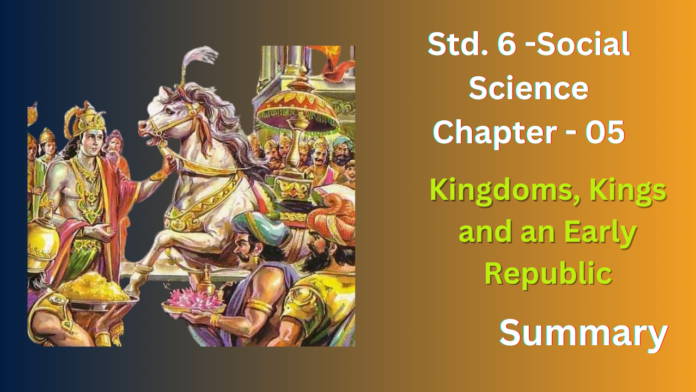NCERT Solutions for Class 6 History Chapter 5
The chapter Kingdoms Kings and an Early Republic explores the rise of kingdoms and early forms of governance in ancient India. Here are the key takeaways:
- Choosing Rulers: In the past, rulers (Rajas) were not always chosen through elections. Some became kings by performing special rituals, like the Ashvamedha sacrifice (horse sacrifice).
- Rise of Big Kingdoms: Over time, smaller settlements grew into larger kingdoms called Mahajanapadas. These kingdoms often had fortified cities with walls for protection.
- Metals and Tools: The discovery and use of metals like copper and bronze led to the development of stronger and more efficient tools, improving agriculture, construction, and craftwork.
- Writing Systems: The Indus Valley Civilization (Harappans) developed a writing system, though it hasn’t been fully deciphered. Writing might have facilitated communication and record-keeping for early kingdoms.
- The Wheel: The invention of the wheel revolutionized transportation, making it easier to move goods and people over longer distances. It also helped in pottery making.
- The Plough: The plough, a tool used for tilling the land, allowed farmers to prepare soil more effectively, leading to increased agricultural productivity.
- Early Republic: The chapter might briefly mention the possibility of early republics existing alongside kingdoms, though details would likely be covered in a separate chapter.
NCERT Solutions for Class 6 History Chapter 5
Let’s recall
1. State whether true or false
(a) Rajas who let the ashvamedha horse pass through their lands were invited to the sacrifice.
(b) The charioteer sprinkled sacred water on the king.
(c) Archaeologists have found palaces in the settlements of the janapadas.
(d) Pots to store grain were made out of Painted Grey Ware.
(e) Many cities in mahajanapadas were fortified.
Ans : (a) False
(b) False
(c) True
(d) True
(e) True
2. Fill in the chart given below with the terms: hunter- gatherers, farmers, traders, craftspersons, herders.
Ans : Hunter- gatherers, Farmers, Traders, Craftspersons, Herders.
Hunter- gatherers : Lived by hunting wild animals and gathering plants
Farmers :Grew crops and raised livestock
Traders : Traded goods between different communities
Craftspersons : Made specialized goods like pottery, tools, and textiles
Herders : Raised and managed herds of animals
3. Who were the groups who could not participate in the assemblies of the ganas?
Ans : The groups who could not participate in the assemblies of the ganas (depending on the specific source and region) were likely:
- Shudras: The fourth social class in the caste system, often excluded from political participation.
- Women: Generally not included in political assemblies during this period.
- Dasas/Dasis: Slaves had no political rights or participation.
Let’s discuss
4. Why did the rajas of mahajanapadas build forts?
Ans : The rajas of the mahajanapadas built forts for several key reasons:
- Defense: The primary reason was for protection. Fortified cities with walls and other defensive structures provided a crucial advantage during warfare. They served as a barrier against attacks from rival kingdoms, bandits, or other threats.
- Security and Control: Forts not only protected the royal family and elites but also offered a safe haven for citizens and their valuables during times of conflict. This helped maintain order and stability within the kingdom.
- Display of Power: Grand and imposing forts also served as a symbol of the raja’s power and authority. The size, strength, and strategic location of the fort could project an image of might and deter potential challengers.
- Economic Hubs: Fortified cities often became centers of trade and commerce. The security provided by the forts attracted traders and merchants, leading to economic prosperity. Taxes collected within the fort could also contribute to the kingdom’s treasury.
- Administrative Centers: Forts often housed the royal palace, administrative buildings, and other important structures. This centralized location facilitated governance and control over the surrounding territories.
FAQ’s
What is covered in Class 6 History Chapter 5: “Kingdoms, Kings, and an Early Republic”?
Class 6 History Chapter 5 delves into the governance structures, societal dynamics, and political transitions of ancient kingdoms, kingships, and the emergence of early republics, providing a comprehensive understanding of ancient civilizations.
How can NCERT solutions for Class 6 History Chapter 5 help in understanding kingdoms, kings, and early republics?
NCERT solutions offer detailed explanations and analyses of historical events and concepts related to kingdoms, kingships, and early republics, helping students grasp the complexities of ancient governance and societal structures.
Where can I find NCERT solutions for Class 6 History Chapter 5?
NCERT solutions for Class 6 History Chapter 5 can be found online or in study materials provided by educational platforms or institutes specializing in academic resources.
When should I refer to NCERT solutions for Class 6 History Chapter 5?
NCERT solutions are beneficial for reinforcing learning, clarifying doubts, and preparing for exams. They can be used alongside regular study or as a revision tool before assessments to enhance understanding of ancient civilizations.
What topics are discussed regarding kingdoms, kings, and an early republic in Class 6 History Chapter 5?
Class 6 History Chapter 5 explores various aspects such as the rise of kingdoms, the role of kings, and the transition to early republican forms of governance in ancient civilizations, offering valuable insights into the evolution of political systems.


